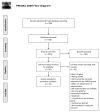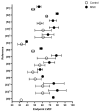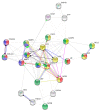Efficacy and Mode of Action of Mesenchymal Stem Cells in Non-Ischemic Dilated Cardiomyopathy: A Systematic Review
- PMID: 33291410
- PMCID: PMC7762005
- DOI: 10.3390/biomedicines8120570
Efficacy and Mode of Action of Mesenchymal Stem Cells in Non-Ischemic Dilated Cardiomyopathy: A Systematic Review
Abstract
Non-ischemic dilated cardiomyopathy (NIDCM) constitutes one of the most common causes to non-ischemic heart failure. Despite treatment, the disease often progresses, causing severe morbidity and mortality, making novel treatment strategies necessary. Due to the regenerative actions of mesenchymal stem cells (MSCs), they have been proposed as a treatment for NIDCM. This systematic review aims to evaluate efficacy and mode of action (MoA) of MSC-based therapies in NIDCM. A systematic literature search was conducted in Medline (Pubmed) and Embase. A total of 27 studies were included (3 clinical trials and 24 preclinical studies). MSCs from different tissues and routes of delivery were reported, with bone marrow-derived MSCs and direct intramyocardial injections being the most frequent. All included clinical trials and 22 preclinical trials reported an improvement in cardiac function following MSC treatment. Furthermore, preclinical studies demonstrated alterations in tissue structure, gene, and protein expression patterns, primarily related to fibrosis and angiogenesis. Consequently, MSC treatment can improve cardiac function in NIDCM patients. The MoA underlying this effect involves anti-fibrosis, angiogenesis, immunomodulation, and anti-apoptosis, though these processes seem to be interdependent. These encouraging results calls for larger confirmatory clinical studies, as well as preclinical studies utilizing unbiased investigation of the potential MoA.
Keywords: dilated cardiomyopathy; mesenchymal stem cells; mode of action; regeneration.
Conflict of interest statement
The authors declare no conflict of interest.
Figures





Similar articles
-
Human umbilical cord blood derived mesenchymal stem cells improve cardiac function in cTnT(R141W) transgenic mouse of dilated cardiomyopathy.Eur J Cell Biol. 2016 Jan;95(1):57-67. doi: 10.1016/j.ejcb.2015.11.003. Epub 2015 Nov 21. Eur J Cell Biol. 2016. PMID: 26655348
-
C-Kit Positive Cardiac Stem Cells and Bone Marrow-Derived Mesenchymal Stem Cells Synergistically Enhance Angiogenesis and Improve Cardiac Function After Myocardial Infarction in a Paracrine Manner.J Card Fail. 2017 May;23(5):403-415. doi: 10.1016/j.cardfail.2017.03.002. Epub 2017 Mar 8. J Card Fail. 2017. PMID: 28284757
-
Intramyocardial bone marrow mononuclear cells versus bone marrow-derived and adipose mesenchymal cells in a rat model of dilated cardiomyopathy.Cytotherapy. 2017 Aug;19(8):947-961. doi: 10.1016/j.jcyt.2017.05.006. Epub 2017 Jun 30. Cytotherapy. 2017. PMID: 28673775
-
Safety and Effectiveness of Intravascular Mesenchymal Stem Cells to Treat Organ Failure and Possible Application in COVID-19 Complications.Pain Physician. 2020 Aug;23(4S):S391-S420. Pain Physician. 2020. PMID: 32942796 Review.
-
Mesenchymal stem cell exosomes in bone regenerative strategies-a systematic review of preclinical studies.Mater Today Bio. 2020 Jun 27;7:100067. doi: 10.1016/j.mtbio.2020.100067. eCollection 2020 Jun. Mater Today Bio. 2020. PMID: 32695985 Free PMC article. Review.
Cited by
-
Disease-Focused Research Using Stem Cells.Biomedicines. 2021 Nov 8;9(11):1643. doi: 10.3390/biomedicines9111643. Biomedicines. 2021. PMID: 34829871 Free PMC article.
-
Bone marrow mesenchymal stem cells transport connexin43 via tunneling nanotubes to alleviate isopreterenol-induced myocardial hypertrophy.Stem Cell Res Ther. 2025 May 6;16(1):229. doi: 10.1186/s13287-025-04339-w. Stem Cell Res Ther. 2025. PMID: 40329337 Free PMC article.
-
Mesenchymal stromal cells to treat patients with non-ischaemic heart failure: Results from SCIENCE II pilot study.ESC Heart Fail. 2024 Dec;11(6):3882-3891. doi: 10.1002/ehf2.14925. Epub 2024 Jul 22. ESC Heart Fail. 2024. PMID: 39039797 Free PMC article. Clinical Trial.
-
Cell therapy for nonischemic dilated cardiomyopathy: A systematic review and meta-analysis of randomized controlled trials.Stem Cells Transl Med. 2021 Oct;10(10):1394-1405. doi: 10.1002/sctm.21-0094. Epub 2021 Aug 4. Stem Cells Transl Med. 2021. PMID: 34346555 Free PMC article.
-
Stem cell therapy for non-ischemic dilated cardiomyopathy: a systematic review and meta-analysis.Syst Rev. 2024 Nov 8;13(1):276. doi: 10.1186/s13643-024-02701-2. Syst Rev. 2024. PMID: 39516841 Free PMC article.
References
-
- Pinto Y.M., Elliott P.M., Arbustini E., Adler Y., Anastasakis A., Böhm M., Duboc D., Gimeno J., De Groote P., Imazio M., et al. Proposal for a revised definition of dilated cardiomyopathy, hypokinetic non-dilated cardiomyopathy, and its implications for clinical practice: A position statement of the ESC working group on myocardial and pericardial diseases. Eur. Heart J. 2016;37:1850–1858. doi: 10.1093/eurheartj/ehv727. - DOI - PubMed
Publication types
Grants and funding
LinkOut - more resources
Full Text Sources

